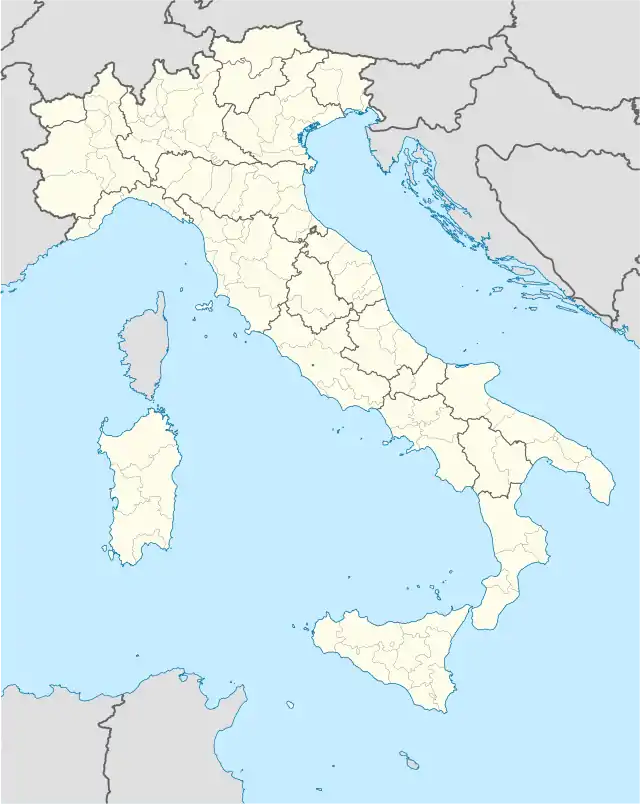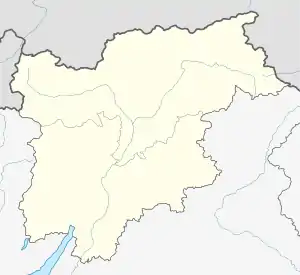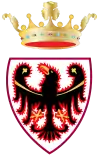Luserna
Luserna (Cimbrian: Lusérn, German: Lusern) is a comune (municipality) in Trentino in the northern Italian region Trentino-Alto Adige/Südtirol, located about 25 kilometres (16 mi) southeast of Trento. As of 31 December 2004, it had a population of 284 and an area of 8.2 square kilometres (3.2 sq mi).[3]
Luserna
Lusérn | |
|---|---|
| Kamou vo Lusérn Gemeinde von Lusern Comune di Luserna | |
 Square in Lusérn | |
-Stemma.png.webp) Coat of arms | |
Location of Luserna 
| |
 Luserna Location of Luserna in Italy  Luserna Luserna (Trentino-Alto Adige/Südtirol) | |
| Coordinates: 45°55′N 11°19′E | |
| Country | Italy |
| Region | Trentino-Alto Adige/Südtirol |
| Province | Trentino (TN) |
| Government | |
| • Mayor | Luigi Nicolussi |
| Area | |
| • Total | 8.2 km2 (3.2 sq mi) |
| Elevation | 1,333 m (4,373 ft) |
| Population (31 December 2007)[2] | |
| • Total | 300 |
| • Density | 37/km2 (95/sq mi) |
| Time zone | UTC+1 (CET) |
| • Summer (DST) | UTC+2 (CEST) |
| Postal code | 38040 |
| Dialing code | 0464 |
| Website | Official website |
Lusérn borders the following municipalities: Caldonazzo, Lavarone, Levico Terme, Pedemonte, Rotzo and Valdastico.
Cimbrian culture and language


Lusérn is the centre of Cimbrian language and culture. In the 2001 census, around 90% of the people of Lusérn stated Cimbrian, an Upper German dialect of the Germanic language, to be their first language.[4] Formerly, Cimbrian was also spoken in neighbouring Lavarone and in the so-called Seven Communities and Thirteen Communities.[5] A cultural institute was decreed by provincial law and receives funds from the Italian state to help preserve the unique tradition, culture and language.[6]
The Cimbrian spoken in Lusérn is a slightly different dialect from Cimbrian spoken elsewhere.[7]
| Cimbrian | German | English |
|---|---|---|
|
Vatar ünsar |
Vater unser |
Our Father |
Demographic evolution

Notes and references
- "Superficie di Comuni Province e Regioni italiane al 9 ottobre 2011". Istat. Retrieved 16 March 2019.
- "Popolazione Residente al 1° Gennaio 2018". Istat. Retrieved 16 March 2019.
- All demographics and other statistics: Italian statistical institute Istat.
- "Tav. I.5 - Appartenenza alla popolazione di lingua ladina, mochena e cimbra, per comune di area di residenza (Censimento 2001)" (PDF). Annuario Statistico 2006 (in Italian). Autonomous Province of Trento. 2007. Retrieved 2011-05-12.
- Schweizer, Bruno (2008), James R. Dow (ed.), Zimbrische Gesamtgrammatik (in German), Stuttgart: Franz Steiner Verlag
- "Autonomous Province of Trento and local linguistic minorities" (PDF). Minoranze Linguistiche - servizio per la promozione delle minoranze linguistiche locali. Autonomous Province of Trento. 2011. Retrieved 2011-05-12.
- "Vaterunser (Luserner Zimbrisch)". (in Lusérn Cimbrian). Kulturinstitut Lusern. 2006. Retrieved 2011-05-13.
- "Das Vaterunser auf Lusérner Zimbrisch". (in Cimbrian). Frankfurter Allgemeine Zeitung. 2006. Retrieved 2011-05-13.
